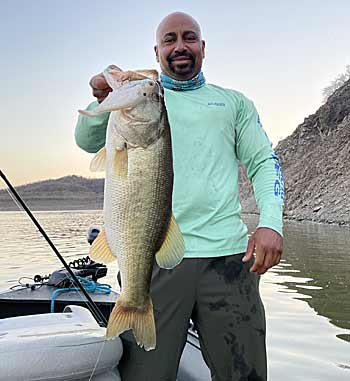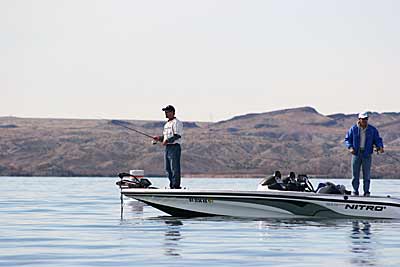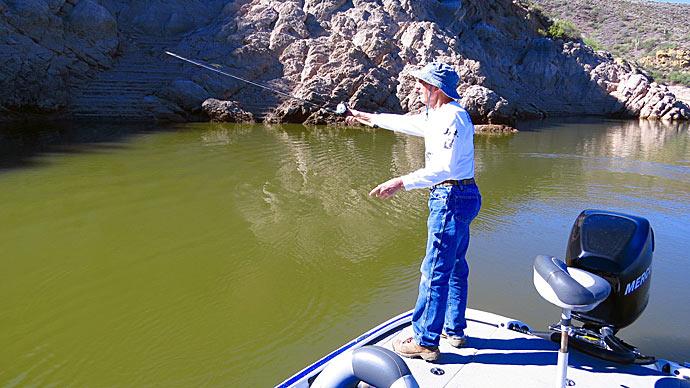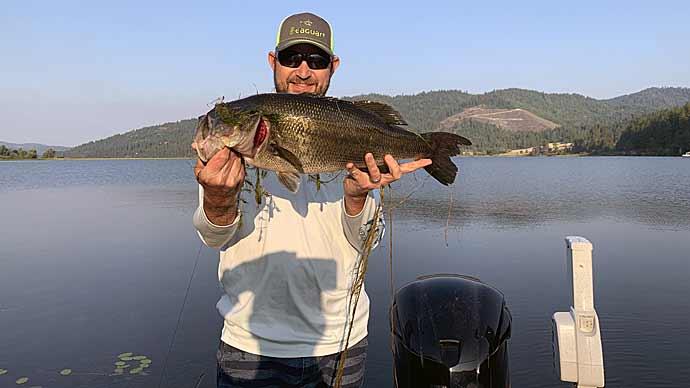
As a doctor and a Type I diabetic, David Bebawy knows what it takes to stay healthy, work a stressful job, and still take time for fishing tournaments and epic fishing trips. Doc, as everyone calls him, is a hospitalist doctor. “It has bad and sad moments but lots of joy as well,” he says, “it’s my livelihood, but not all that I am.”
Single and with no kids, Doc says fishing is like his family. The hospital is very understanding – they know that fishing helps him de-stress. Doc is a non-boater, so he gets to meet a lot of great anglers, and he says he learns from all of them.
He’s gleaned some invaluable tips for non-boaters and advice on staying in good shape so you can enjoy your fishing for years to come.
Stay Healthy
Doc was diagnosed with Type I diabetes when he was 15 years old, so he knows what it takes to stay healthy. “Doctors always tell you the same thing because it’s true,” he says, “losing weight does help with everything.” Taking a few pounds off helps your heart, joints, and overall health. “Fishermen tend to have a bad diet, especially on the water, and often their only exercise is fishing,” he says. Doc says that ideally, you should get a snack in your system every two to three hours. Fishing makes you burn calories and lose water, so drinking water regularly while you fish is essential.
Although snacking every two to three hours is ideal, the key is to make those snacks good for you, not junk food. Doc says that Rx Bars (www.rxbar.com) are perfect, and he recommends you drink one or two bottles of water every two to three hours. This will help your fishing because, as we all know, fishing all day can be exhausting. Being well nourished and hydrated will help you keep your focus.
When you aren’t on the water, you should do thirty to sixty minutes of cardio, ideally four times a week. Doc says fishermen like to insist that they don’t have time to work out, but he says no matter who you are, you have thirty to sixty minutes to spare for exercise – you don’t want to. You’d rather sit and watch television or surf the net for fishing videos. Get a workout buddy – your wife or your significant other is perfect. Otherwise, you probably won’t do it. Have someone keep you accountable.
People always tell him that they won’t do strength training and cardio. If that’s the case with you, he says pick cardio because it will strengthen your heart and lungs. You can hold dumbbells or do curls or shoulder presses while doing your cardio – two birds with one stone.
He says that for low-impact cardio that is easy on your knees, choose the elliptical or the bicycle over a treadmill. Or, if you insist on doing weights, do circuit training and use supersets to keep yourself sweating and breathing hard. That’s what it takes.
Doc takes his advice, and he credits his dad for that. “Dad was a doctor too,” he explains, “and he told me that medicine allowed him to support his habit, which is a healthy obsession – fishing.” For people who love fishing, it re-ignites them and keeps them in a reasonable frame of mind.
Epic Trip To Mexico
Doc also takes his advice when making time for the things he loves. He recently went on an epic bass fishing trip to Mexico’s Lake Baccarac with some fishing buddies. They flew out of Arizona’s Deer Valley Airport on private planes to Nogales, Mexico, stopped there to jump on a plane for Obregon for customs, then flew into the airstrip at Baccarac Lodge. The guides were already on the boats waiting for them. “We got spoiled,” Doc says, “and the total cost was like $2800 to $3000 for absolutely everything but tips.” That included the flights, food, drinks, the lodge, everything. They limit you to forty pounds for luggage, so they called beforehand to see what everyone was catching the fish on. This helped them stay under the limit, especially when they were told that swimbaits weren’t necessary.

The fishing at Baccarac is outstanding. Doc says they didn’t have to do much running – only about fifteen to twenty minutes after taking off, they’d be on a great spot. The guides would ask them if they wanted to fish the shore or go to a rattle bait spot.
Doc says the rattle bait spots were crazy. “We’d be in the middle of the lake in like forty feet of water,” he says, “and just casting out everywhere.” In four days, they caught 300 to 400 bass, including multiple nine-pounders and one that was almost twelve pounds—definitely an epic trip.
Their main bite was those lipless rattling cranks – Doc says his favorite was the Strike King Red Eyed Shad ¾-ounce bait. He’s had his Red Eyed Shad for so long that it has no paint left, but the big bass were still all over it. They also caught bass on 12-inch worms and spinnerbaits, but the rattle baits were best. In low light, the noisier baits produced well, and they’d switch to the shiny baits with a more subtle sound in bright light.
“The guides could tell from your hookset whether they needed to get the net or not,” says Doc. “They are just phenomenal.” He says he’s never had more fun in his life. His biggest fish, an 11.81, jumped three times even though he had the rod buried in the water. It’s a good thing he keeps his heart healthy.
Another thing that made the trip so much fun was that the guides were so competitive. Their guides, Six-Toe and Manuel, would constantly rib each other about whose clients were catching the better fish. Doc’s big fish won the contest.
Doc's Tips For Non-Boaters
Doc fishes many tournaments as a non-boater, both teams, and pro-ams. He usually fishes with Daniel Elias for the team tournaments, and they do very well together. As for the pro-ams, well, you never know who you’re going to get drawn with, and Doc says he’s been very fortunate and has learned a lot of fishing as a non-boater. The biggest thing, he says, is to acclimate yourself to your surroundings and to be flexible.
He says one of two things will happen when you’re the non-boater. You will be back seated, or the guy up front will share the water with you. You need to figure out which way the day will go right away. If the boater is going hard and pointing the nose of the boat where the good stuff is, you’re being back seated. If the pro shares, they also learn from you, watching what is happening and who catches what.

Doc is used to fishing with Daniel, and they have a system. If Daniel throws something surface and fast, Doc will follow up with a sub-surface lure, casting right behind Daniel’s lure when it’s about halfway to the boat. He tried that with a different guy once and was told if he got another lure up that way, he would get his line cut. He apologized all over the place, and they made peace, but be aware that some guys draw an imaginary line halfway down the boat, and all the water ahead of that line is theirs, and theirs alone.
Doc doesn’t mind when that happens because he says there is always some way for you to catch fish. For instance, if your boater is pitching to the tules with a heavy jig and getting it back into the sticks, try tying on a Senko and pitching it to the edges. Or you can even try a different color. If he’s using 16-pound line, use 10. As with Daniel, he’ll throw a 4-inch Yamamoto grub on a little pea head jig and swim it, especially if the boater is cool with him fishing behind his lure. It’s a game, Doc says, and you can’t stop whether you have the best boater or the worst.
If the pro doesn’t want you fishing past the middle of the boat, a split-shot rig is an excellent tool for the non-boater, Doc says. Just grab your spinning rod and tie on a small worm with a 1/0 worm hook, then pinch a split-shot a foot or so in front of the bait. You can toss that to the shore behind the boat and drag it along. “It’s everything a bass wants to eat,” Doc explains, “and you can even let the boat do all the work.” He says you can often catch many fish that the pro might be missing because he’s being too aggressive.
Sometimes a boater will tell you what to do, and Doc always gives them the benefit of the doubt, but if it just isn’t working, he won’t die on it. If neither one of them is catching anything, he’ll switch. Sometimes the boater is so focused on what he believes will work that he won’t take any advice from a non-boater.
Doc says once he was drawn with an older guy who had won tens of boats back in the day. This tournament was at Lake Mead, a notoriously difficult lake, and as they were motoring into a cove, Doc spotted shad flicking on the surface near the back. He threw a jig to shore, dragged it into the water, hopped it a couple of times, and caught a three-and-a-half-pound bass. The bass were pushing the shad like crazy. He made another cast and caught another fish, and after he got the fish put away, he looked up, and the guy was driving the boat right over the action. He tried to tell the guy, but he didn’t listen. Doc looked over the side into the gin-clear water and saw an enormous ball of shad swim away, with the bass behind them.
Sight Fishing
For the most part, Doc says if he knows a pro-am tournament will be a sight-fishing game, he won’t fish it. But if he somehow gets hooked up with a guy who is sight fishing, he says there are two ways to go. Either the guy will be pointing the boat right at the beds and won’t want you making any noise or even wearing bright colors, or they’ll be cool, but you still won’t be fishing their beds. Fortunately, there are a lot of options for this situation.
“First of all,” says Doc, “not all the fish are spawning simultaneously. You can get lucky and catch a real pig – a female just moving up. Or you can throw to the shore behind the boat, and you could catch a bass off a bed the boater didn’t even know was there.” His go-to bait for situations like this is a Senko, wacky rigged. Your pro is wedged up on shore, and you have all the water in the world behind you, so you can fan-cast the entire area, working from deep to shallow. Just cast out a Senko, let it fall to the bottom, then keep popping it up and letting it fall.
Backseater Etiquette
The way Doc looks at it, being a non-boater is like getting a full-day guide trip, so he never gives his pro less than $60-$80 for gas. “The pro has all the responsibility for the upkeep of the boat, gas, oil, towing – all of it, and he’s letting you in the boat and taking you to the places where he catches fish, so it’s a pretty sweet gig,” he says. You’d pay hundreds for an actual guide trip, plus you have an opportunity to win a bunch of money on top of that.
He limits himself to bringing six rod and reel combos and just the tackle he can fit in a single duffel bag. For him, this is two Plano boxes with the terminal tackle he thinks he’ll need and a couple of 1-gallon plastic zip bags for his soft baits. The pro usually has a cooler you can share with him, and Doc keeps his lunch and drinks in a separate bag.
The biggest key to a good day as a non-boater is to ask first if you have questions about where the pro would like you to cast, etc. You’re only going to be on the guy’s boat for one day, and as Doc knows, there is always something you can do to catch fish, no matter what the guy up front is doing. So be cool, have fun, and never quit.



